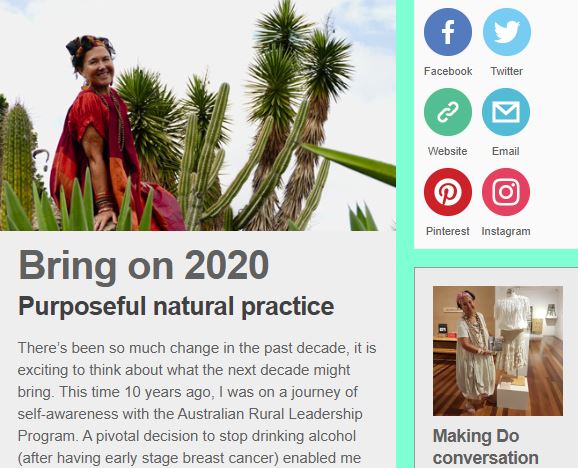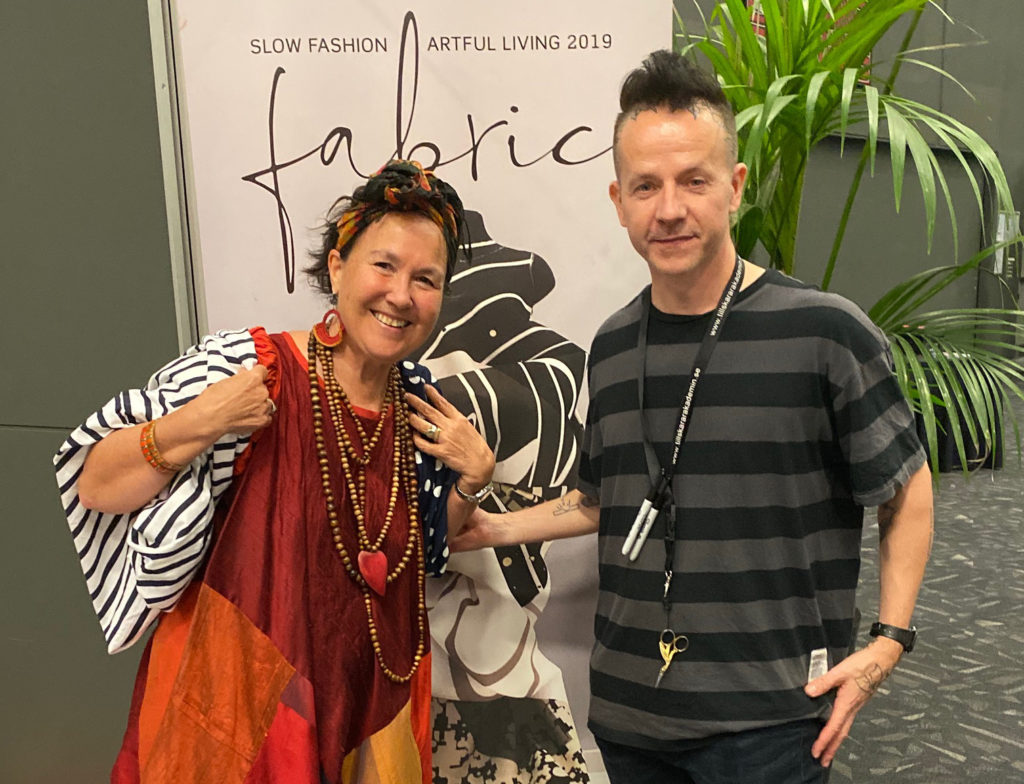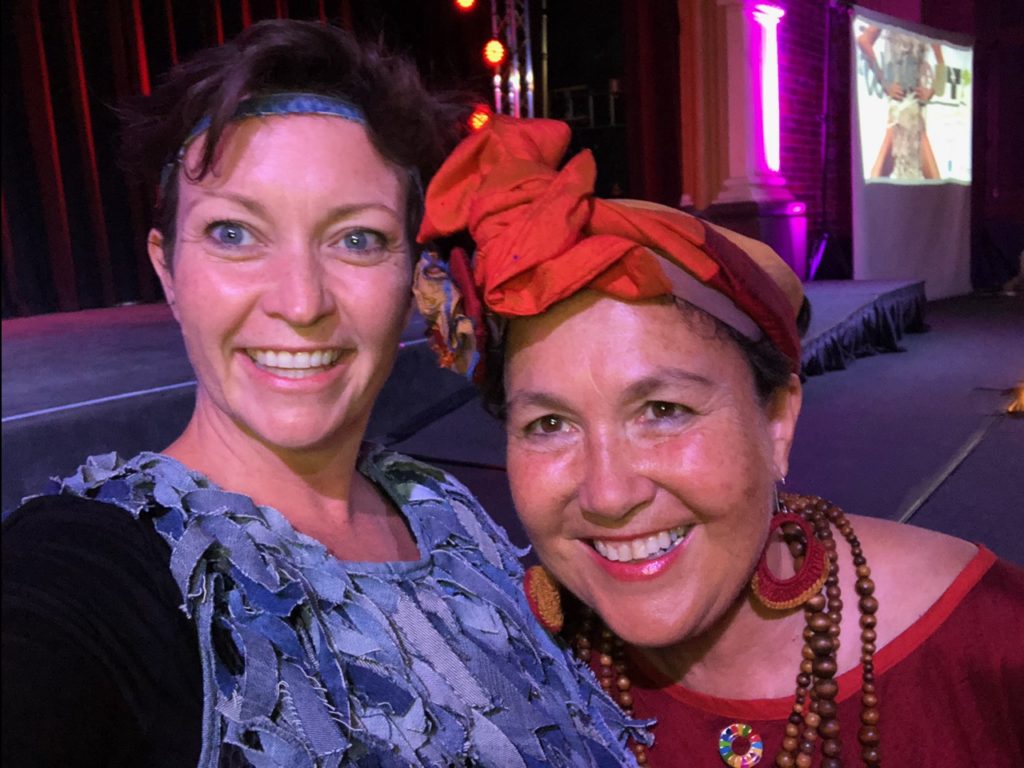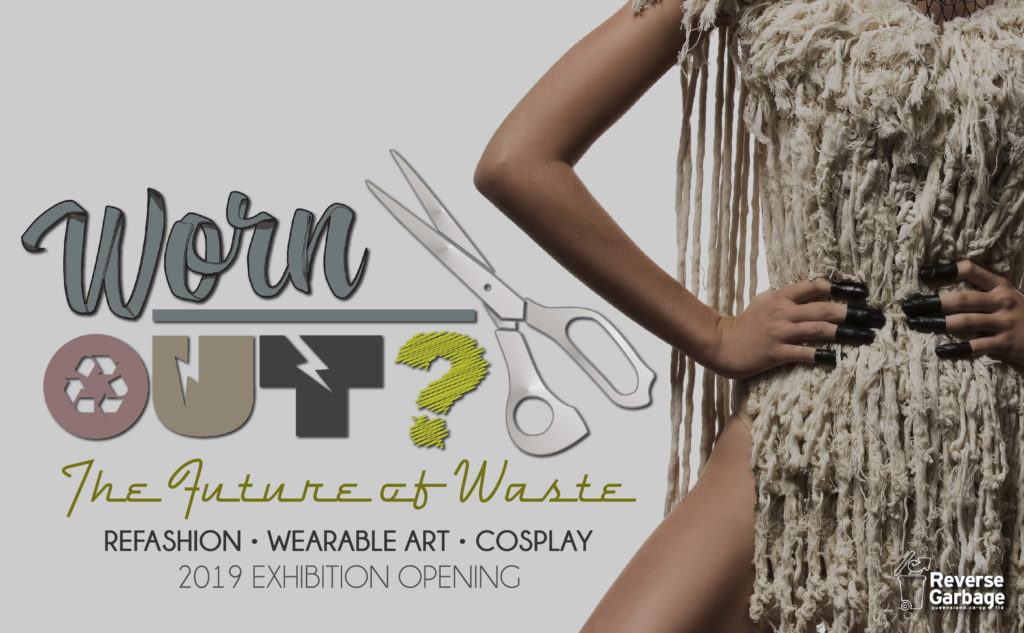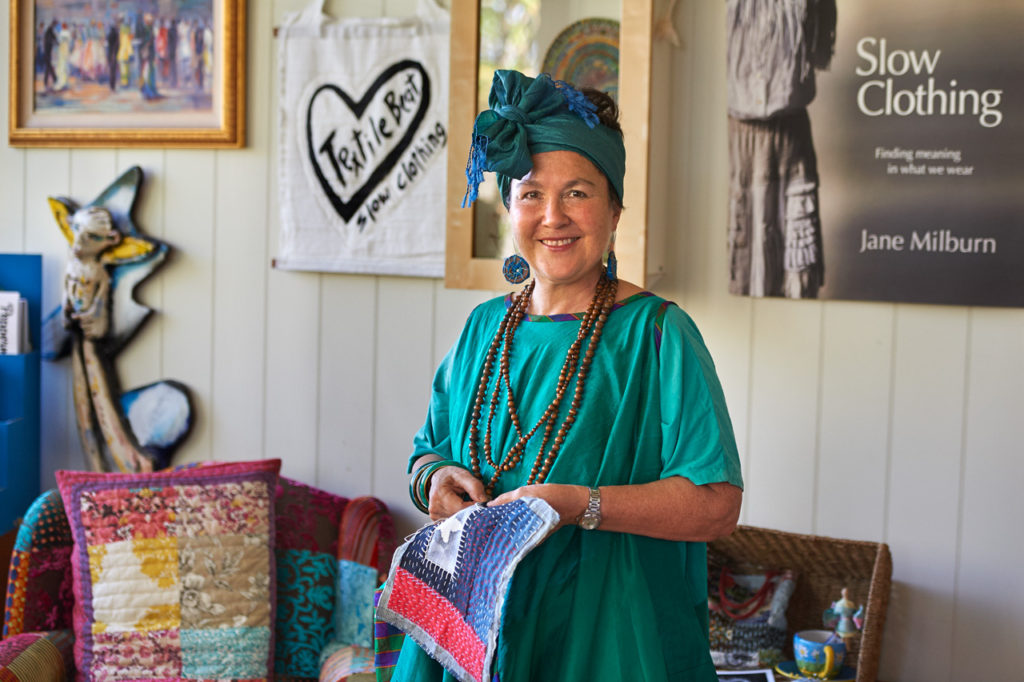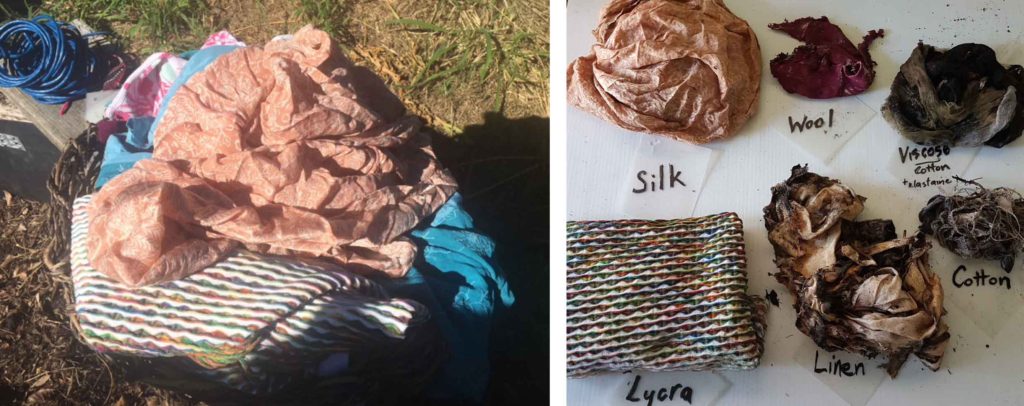Small individual actions can, and do, create big changes. About 10 percent of our carbon footprint is embedded in the clothes we wear therefore our choices matter. Since 2013, Jane Milburn has been raising awareness about ways to reduce our material footprint through slow clothing actions: think, choose natural, quality, local, have few, care for what you have, make your own, revive, upcycle and salvage. In this news report, ABC journalist Lucy MacDonald outlined three ways for dress sustainably: buy sustainable fibres, choose pre-loved, and shop your wardrobe. She chatted with Jane about upcycling and reskilling so we can get more life out of what we aready own.
Zero Waste Sewing, the book
Sewing in straight lines and basic math skills are all that’s required to achieve success with the simplest of the handmade clothing projects in a clever new book Zero Waste Sewing from South Australia’s Elizabeth Haywood.
Zero Waste Sewing is a practical and resourceful book based around 16 projects to make, wear and enjoy, with plenty of opportunity to modify and adapt them to suit your shape and preferences.
Through her ingenious patterns, Liz inspires a sustainable, resourceful approach by showing us how to use 100 per cent of the fabric, with nothing left over. Such a great goal to work towards!
The Craft of Clothes is Liz’s blog about sewing and fashion, and her earlier book The Dressmakers Companion, reflect her background and experience as a pattern maker and sewing teacher.
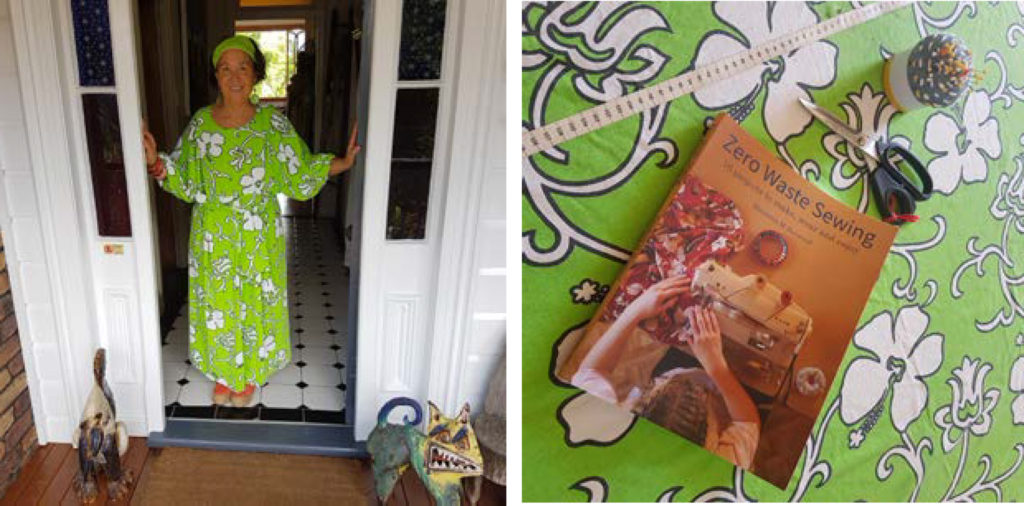
Supporting local farmers
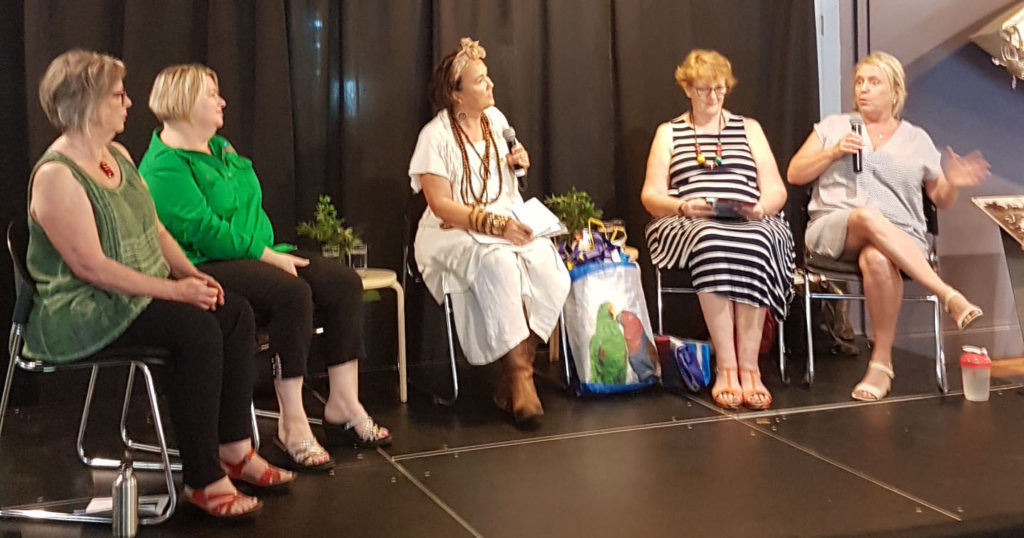
Jenni Guse, Tash Johnston, author Jane Milburn, Flora Bradley and Amanda Schultz talk local farming
Bring on 2020
On the Textile Beat enews December 2019 is in your inbox now if you’re subscribed, or you can read here or register on the right hand side of this website.
There’s been so much change in the past decade, it is exciting to think about what the next decade might bring. This time 10 years ago, I was on a journey of self-awareness with the Australian Rural Leadership Program. A pivotal decision to stop drinking alcohol (after having early stage breast cancer) enabled me to focus energy in a creative and purposeful way. Through Textile Beat, my background, interests, skills, experience and knowledge have come together to influence change and create awareness of more sustainable ways of dressing (Here’s one of my early Stitch in Time columns). Since 2013, I’ve had nearly 600 engagements around Australia spreading ideas for reducing our material footprint and have seen so much change in that time. I’ve been awarded a Churchill Fellowship based on that work which enables me to travel to Japan, the United States, the United Kingdom and Europe next year to investigate ways that upcycling/mending can help reduce our textile waste and enhance wellbeing. Wishing you and me well for our next decade of life.
Sewing a fresh seam
By Jane Milburn *
Sowing or sewing? If you are a gardener or a sewist, you reap what you sow or sew. While there are many gardeners among us growing some food, there are fewer sewists making their own clothes.
In the same way many are sowing seeds to yield nutritious home-grown, local, natural food, it is time to invest energy in sewing local natural clothes.
With global supply chains pumping out 80 billion garments each year, most people have lost sight of where and how things are made, and what from. Slavery combined with increasing use of synthetic/plastic fibres, has led many to buy two to four times what we used to, resulting in waste and pollution, and a loss of skills and knowledge about clothes.
Over the past two decades, globalisation and production efficiencies have meant it is cheaper to buy clothes than make them. We’ve got used to affordable, ever-changing styles. Shopping is addictive and we’re encouraged to buy quantity over quality for the good of the economy. It is only when we stop and think about why clothes are so cheap that we come to understand they are not properly costed, that exploitation of people and resources exists in the system.
Each of us influences the future of the fashion industry through our buying choices. Surely the beginning of a new decade is a great time to turn over a new leaf. Let’s think about fewer clothes of better quality that we wear for longer.
Reuse to reduce textile waste
WornOut is an annual showcase of creativity and resourcefulness organised by Reverse Garbage Queensland to showcase designers working to reduce textile waste, with the 2019 theme being The Future of Waste.
As ambassador, Jane Milburn said that future really must be for us to waste nothing – and invest creative effort to keep materials endlessly circulating. Jane and ABC Brisbane’s Rebecca Levingston co-hosted this year’s event.
‘There has never been a more important time to change our thinking and actions around reuse – to fully value and appreciate our planet’s precious resources,’ Jane said.
WornOut is now in its third year and taps into the global awakening about social and ecological impacts of the fashion industry, which contributes up to 10 percent of humanity’s carbon emissions. It is curated by Elizabeth Kingston, supported Brisbane City Council and the Queensland Department of Environment and Science, and was held on November 23 at Princess Theatre with showcases of refashion, wearable art and cos play.
Jane said the purpose of the WornOut showcase is to:
- invest human energy, skills and creativity to transform ‘waste’
- change attitudes about when – if ever – textile resources are ‘wornout’
- show thrift and resourcefulness thriving in the local circular economy
- have fun with what we wear in inclusive and diverse ways
Investigating slow clothing culture
We live in a throwaway society, with an increasing amount of textiles used in the fashion industry made from synthetic fibres and garments produced using underpaid labour. Jane Milburn has a passion for natural fibres and believes behaviour change is needed towards dressing more responsibly, wearing clothes for longer and limiting the amount of textile waste thrown into landfill each year.
Using her campaigning and making skills, Jane created Textile Beat in 2013 and developed a 10-point Slow Clothing Manifesto of ways to reduce our material footprint. During the past six years, Jane has advocated for change across Australia through more than 560 engagements.
WornOUT? The future of waste
Jane Milburn awarded Churchill Fellowship 2019
Jane Milburn of Textile Beat has been awarded a 2019 Churchill Fellowship to investigate ways that hands-on upcycling actions can reduce textile waste and enhance wellbeing.
The fellowship will enable Jane to undertake research across three continents to further her work inspiring social change and contributing to sustainable living across communities through slow clothing practice.
“I feel deeply honoured to be awarded a Churchill Fellowship and I believe this recognition will elevate the slow clothing work I’ve undertaken since observing fashion excess in 2011,” Ms Milburn said.
Regenerating clothes into compost
There is simply no precedent for the volume of clothes in the world today so we are experimenting with ways to keep material resources in local circulation through soil after its initial purpose is served. Soil is our biggest carbon sink and the source of all fresh food and natural fibre, so it truly has superpowers worthy of enriching.
The composting process cycles four of life’s building blocks – carbon, oxygen, hydrogen and nitrogen – back into the soil so that it can support new growth. The clothing fibres need to be moistened to encourage and speed the decomposition process. The fibre becomes food for microbes, bacteria, fungi, moulds, worms, beetles, snails, mites, cockroaches and other critters, which are all part of the process.
By all accounts, when food and clothing go to landfill they emit the greenhouse gas methane which contributes to climate change. We can compost food waste in our backyards and neighbourhoods, so why not our clothing waste? Of course clothing with wearable life can be donated to charities but composting is a solution for cloth that has exhausted other purposes.
I cannot find a textbook that discusses composting clothes to regenerate as organic matter but I did find this online reference. Industrial clothing recycling solutions may arise, but in the meantime composting provides a local solution.
In 2018, I did a backyard experiment and found most of the natural-fibre material swatches (wool, cotton, linen) disintegrated into ‘soil’ within the year while synthetic fibres remained inert. This is because fibres like polyester, nylon, acrylic are plastic, derived from fossil fuels the same as plastic bags, containers and bottles.
This year, we did another experiment with six garments (all started of similar size/volume) made from different fabric types being buried for three months in a compost bin at Bulimba Creek Catchment Sustainability Centre at Carindale in Brisbane.
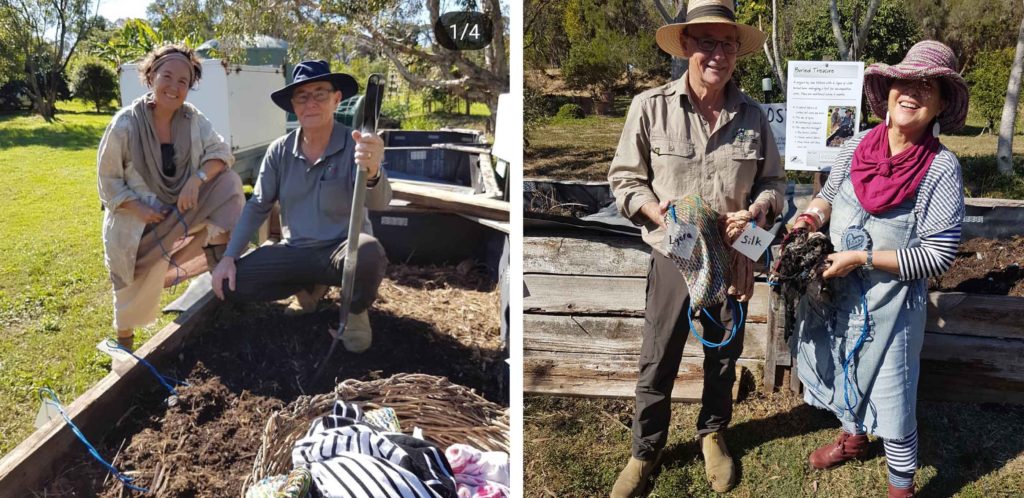
Jane Milburn and Bulimba Creek Catchment Sustainability Centre nursery manager Leigh Weakley bury clothes in late May, left, and dig up in late August 2019.
Five of the garments were natural fibres (wool, cotton, linen, silk, viscose-blend) the sixth was lycra (not expected to breakdown). Most of the thread used to sew garments is polyester (synthetic) so it is not likely to breakdown. Buttons were reclaimed before burial.
